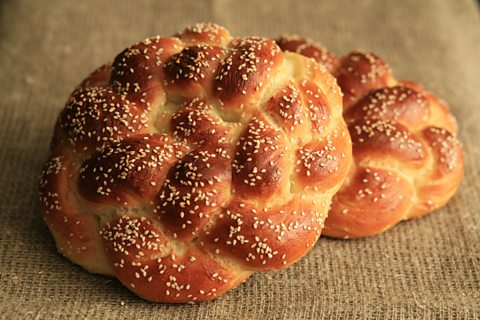Shabbat
Observing ShabbatThe seventh day of the week; a day of spiritual renewal and rest commencing at sunset on Friday and terminating at nightfall on Saturday. is one of the Ten CommandmentsThe list of rules, revealed by God to Moses, found in the Old Testament books of Exodus and Deuteronomy. Also known as the Decalogue.. Jews observe a day of rest to commemorate God resting on the seventh day after he made the world.
Shabbat begins on Friday at sunset and lasts until sunset on Saturday. It is a time for family and community, and during this time services at the synagogueBuilding for Jewish public prayer, study and assembly. are well attended.
No work is to be done on Shabbat. This includes tasks such as cooking and driving.
Orthodox JewsJews who live by the Torah and rabbinic law (halakhah) and who only accept changes that can be supported by the Torah. stick closely to tradition and try to observe Shabbat wherever they are in the world by not working and not lighting candles after sunset on Friday. In order to avoid driving, Orthodox Jews walk to the synagogue during Shabbat.
Reform JewsJews who have adapted their laws and practices as modern life has changed. try to keep Shabbat, but if this is not possible they try not to worry too much. Often Reform Jews light candles after sunset. Also, while they try to complete the symbolic rituals, they may alter the timings. It is permissible for Reform Jews not to keep Shabbat if, for example, they are on holiday. They may also drive to the synagogue to attend services during Shabbat.
Shabbat at home
In Jewish homes, a number of preparations are made before Shabbat. The house is tidied and food is prepared, and two candles are placed on the dining table. These represent the two commandments received by Moses on Mount Sinai related to Shabbat, which were to “remember” and “observe” the SabbathThe seventh day of the week and a day of rest for Jews (Shabbat is Friday sunset to Saturday sunset). Sunday is the day of rest for Christians..
Also on the table will be two loaves of challah breadA special braided bread eaten on Shabbat. to represent the food God provided for the Jews when they were walking through the desert in flight from Egypt.

On Friday evening the Shabbat is welcomed with the lighting of the two candles. Traditionally, the mother of the family places her hands over her eyes and recites a blessing to welcome Shabbat.
The family may visit the synagogue. Depending on the time of the service, this could be before their meal or after. They eat a meal together as a family on Friday evening. Before any food is eaten, blessings are said for the children, and kiddushA prayer sanctifying the Sabbath and festival days, usually recited over wine. is said over the wine to make Shabbat holy. Drinking wine on Shabbat shows that this is a joyful, celebratory time. The bread (challah) is blessed and everyone takes a piece. Typically, the meal lasts for a few hours with everyone enjoying family time, often singing songs and telling religious stories.
On Saturday, after visiting the synagogue, the family shares another meal. The afternoon is spent studying the Torah and playing games as a family.
Shabbat at the synagogue
On Friday evening, prayers are said at the synagogue. In Orthodox synagogues, these prayers happen at sunset, whereas in Reform synagogues they happen at a set time. Shabbat is welcomed with hymns, prayers and psalms called Kabbalat Shabbat.
On Saturday morning there is the main service of the week, with readings from the TorahLaw; teaching. The word Torah can be used in a narrow sense to mean the first five books of the Hebrew Bible (The Five Books of Moses) and also in a wider sense to include the whole of the Hebrew Bible and the Talmud. and Nevi'imProphets. The second section of the Tenakh..
The afternoon service on Saturday includes a reading from the Torah as well as prayers. It is followed by ma'arivA Jewish evening prayer service at which the Shema and Amidah are said., which finishes with the HavdalahMeaning 'distinction'. Ceremony at the conclusion of the Sabbath separating the Sabbath from the working week..
Havdalah
After the sun has set on the Saturday evening, the end of Shabbat is marked with the Havdalah service.
Blessings are performed over a cup of wine to thank God for what he has provided.
A box of spices is passed around for everyone to smell. This reminds Jews that Shabbat is the spice of the week – a time for reflection, family and rejuvenation before the next week.
A candle with several wicks is lit and blessed. The candle brings light into the home after Shabbat has ended.
Question
What is Havdalah?
The ceremony with candles and spices that marks the end of the Shabbat.